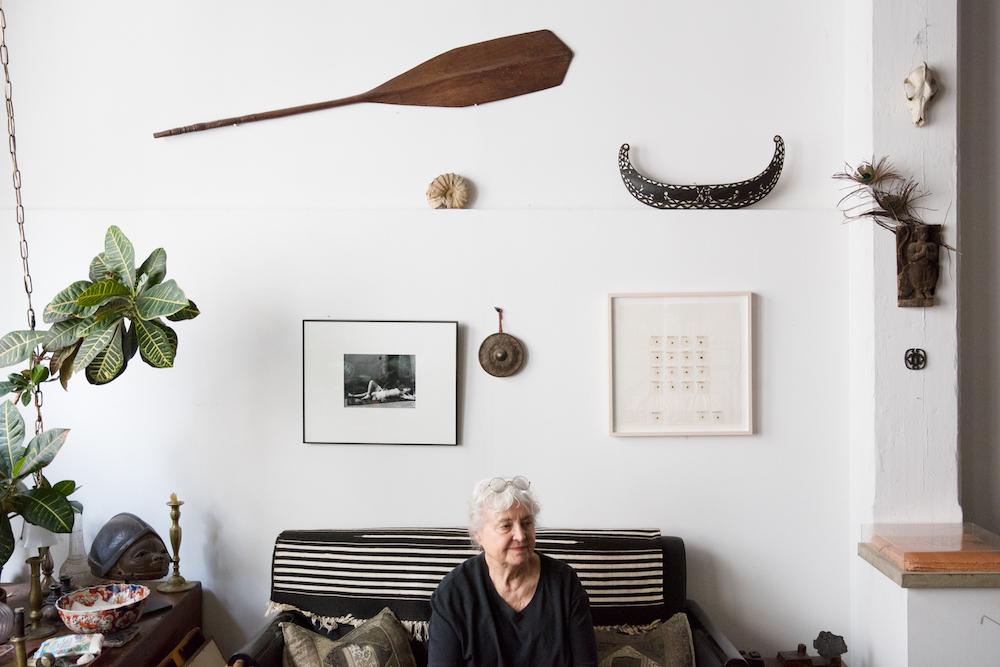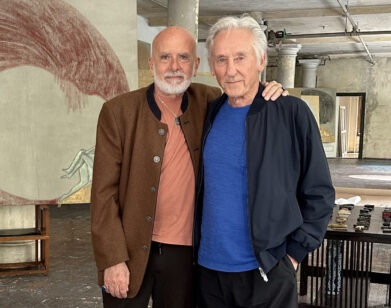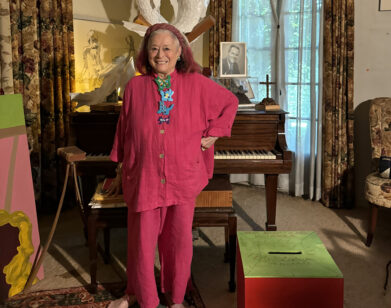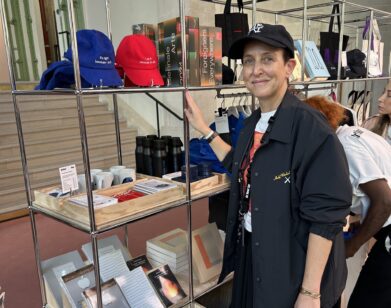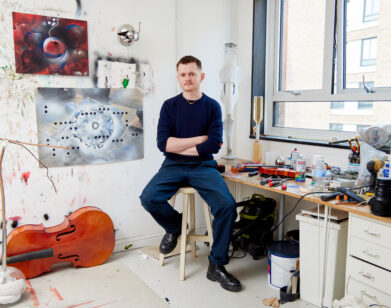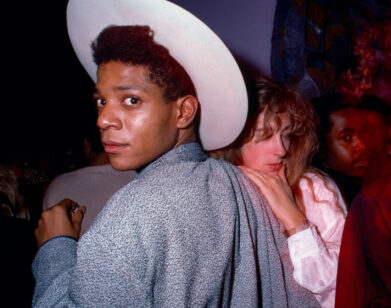Michelle Stuart’s Mythologies
It’s unsurprising that artist Michelle Stuart held early aspirations of becoming a writer. Her photographic grids, which she has constructed for more than a decade, read like unmoored, surrealist fiction. Images of constellations mix with those of mysterious silhouettes, mushroom clouds, and the tumultuous ocean; tropical landscapes are paired with ships arriving at port and intimate letters exchanged between her parents; archaeological sites, natural specimens, and ethnographic portraits collectively invite an anthropological study. Formatted into a grid, these images form webs of visual mythologies, blending autobiography and collective history.
Photography, however, is not the medium for which the Southern California-raised, New York-based artist is known. Now in her early 80s, Stuart traveled the globe during the ’60s and ’70s, creating earthworks as well as imprints and rubbings of soil, rock, and clay on paper and muslin scrolls. Although her use of photography began during this period, her images have never been highlighted—until now, with the exhibition “Michelle Stuart, Theatre of Memory: Photographic Works” at the Bronx Museum of the Arts. As Stuart puts it, the grid has been a part of her visual vocabulary since “forever ago,” and her choice in medium naturally developed.
“I have found, and most artists are probably this way, that [when] you’re working on some kind of idea, the idea makes demands,” she says. “In order to execute the idea, you need a certain material that is going to allow you to do what you’re challenged to do in your imagination. You should use whatever you can and it’s amazing how even if you change the medium, your work is still yours,” the artist continues. Having also completed sculptures in a grid format, she explains, “I find great satisfaction in the rigorous structure of the grid, but I like the organic on the grid so that there’s a combination of structure and chaos.”
Ahead of the opening at the Bronx Museum, we visited Stuart in her plant- and object-filled SoHo studio, which has been her home since 1971. We spoke about everything from her process and archaeology to working with Diego Rivera, while her 16-year-old dog Lola settled at our feet after returning from a walk.
HALEY WEISS: To start off, I’d like to talk about the title of the show, “Theatre of Memory.” How did it come about and what is its meaning to you?
MICHELLE STUART: The title came to my mind when I was doing the piece called My Still Life because [the photographs] were all set-ups—well, most of them, not all of them—but they were all taken in the studio. Essentially, it was “my still life” literally, but the non-literal part was that it was all about memory, which I think photography is about anyway. So at some point very close to the beginning of that piece I starting setting up little theaters using objects in the house that were a part of my memory and a part of my past—the way, long past and the short past. Then I started thinking about putting levels of past behind it so that it had a foreground, a background, and planes; the different planes [are] like the way our memory shifts. Fortunately, when we have all our marbles, [laughs] we can shift our memories very quickly.
I thought of that as being a kind of mini-theater, which goes back to the Greeks because they set up things like that. In fact, in the history of a lot of cultures there is a theater. For example, there are the theaters in Java, [Indonesia] and of that area where they use puppets and they have backgrounds and shadows. So I thought, “Why not play with that idea?” That became the title because, in fact, I looked at all the pieces in the show and thought, “Well, they all really have that within them in terms of content.”
WEISS: How did you choose the objects that you photographed for that piece?
STUART: Helter-skelter. [laughs] Of course we don’t have objects that we don’t like, so I had a panoply of objects to choose from that I’m attached to. But one of them actually has my father’s baby shoe in it. I happened to have it and I thought, “That’s certainly part of a different plane of memory.” It’s not in my actual memory, but it is in my actual memory in that it was my father’s and I do have his genes. So the whole thing is really all about a kind of perception that I have of objects and when they meet in space, but they’re not so esoteric that another person couldn’t present his or her own way of thinking and looking at them … I came upon doing that piece almost by accident and then it kind of came rolling out.
WEISS: In many of your works you use found imagery as well as your own, right?
STUART: Most of them are my photographs. There are some photographs that are not mine, however, the ones that aren’t mine are foraged everywhere, from the internet—not copywritten images—but really, really old images and [images] from TV. In fact, almost anywhere I can cache them. But I usually change them. For example, there’s an image of a person from Samoa that I didn’t take and I got from another location. I frequently change the background. I cut them out and I collage them onto a photograph that I’ve taken. So even the ones that have other photographs are collages.
WEISS: When did photography become one of your media?
STUART: I studied it in the ’60s and it acquiesced for a few years, not many, and then I started using it purely as a document.
WEISS: Of the earthworks?
STUART: Yes, not just to document them, but when I worked on a certain site I would walk around the site and take photographs of it. There are two pieces in the show, I think they’re from ’81, which are pieces that have earth in the middle with photographs [surrounding them that were taken while] walking around the site. So there’s a real continuum in the work there. And the director of the museum wanted me to put those in because she wanted people to see that continuum, so that’s why there are two Codex works—one from Sayreville, New Jersey, and the other I think from a Maya site in the Yucatán.
WEISS: How did you find yourself in Sayreville, New Jersey?
STUART: That’s a long story… Sayreville was a site that [Robert] Smithson liked. Smithson took Charles Simonds to Sayreville and Charles Simonds and Lucy [Lippard] took me to see Sayreville. Charles said, “I know you’re going to love the color of the earth here,” so we went out there and then I went back.
WEISS: When you were making earthworks, was there a sense of community amongst others who were doing the same or was it more of a solitary practice?
STUART: There was a great sense of community mainly among the women artists at the time because we felt left out. I still know most of the women that I knew then, the ones that are still alive.
WEISS: At that time, did you consider what you were doing to be feminist?
STUART: No, I never made “feminist art,” and if I did it was not deliberate. … Very early on I was interested in doing political art, but it was not feminist political art. One of the reasons that I went to Mexico aside from the Maya and the pre-Columbian aspect of it was that I wanted to work with [Diego] Rivera, which I did, on a mural that he was painting at the time. But at some point I realized that I wasn’t going to be a political artist, it just wasn’t in my repertoire. I think you have to be really angry, I think it helps, and I wasn’t that angry. I’m much more philosophical in my thought. I veer more toward the philosophical and the poetic than I do toward the alert and angry. You find that, and luckily I found it rather early, so I didn’t waste any time. I have made on occasion posters and things like that for political reasons but not my work. [When we were making earthworks,] it was a group of women who were really under the aegis of Lucy Lippard, though she wouldn’t have said that because she was just the vehicle of authority that we could gather around. It was mostly about getting women teaching jobs and trying to get in major shows. It was a very solid group of very good artists.
WEISS: How old were you when you went and worked with Rivera?
STUART: I was about 18.
WEISS: How did you end up in Mexico?
STUART: When I graduated from high school, this is in Los Angeles, I was very interested in taking a trip to Mexico to see the archeological sites. So three other people and myself drove down there. Mexico doesn’t seem alien to Californians, Southern Californians, anyway, so we just got in the car and drove down there. We stayed a while. I met some people that said, “You should come back and work at Bellas Artes,” so I went back to LA, I went to art school briefly, and I thought, “I’m going to write this person and see if he can find me a place to stay [in Mexico],” and he did with a friend of his, it was a family. While I was with that family the daughter who was my age knew that Rivera was looking for assistants so she said, “Why don’t we go over there,” and that’s what I did.
WEISS: You’ve been in New York since the ’60s. How has your relationship to nature and the cosmos changed by being in a city?
STUART: It hasn’t really because I get out of the city all the time. I love the city; I’ve always liked New York even before I lived in New York. It represents something, I think, and it would be trite to say what it represents really because it’s been said so many times. I did live in Paris for three years and I prefer New York. I get out a lot; I take trips. Not as much anymore because it’s not as much fun as it used to be. Flying used to be so great but now it’s more of a trial. Getting there used to be fun. And then in the summers, I go to the country, any country. [laughs]
WEISS: When you leave the city and go to the country, are you mainly making photographs or do you still make earthworks?
STUART: Mainly photographs. I was out in California over the holidays and I was working with some photographs I took out there just now, actually, which were all different photographs of the sunset. They’re really interesting because El Niño has changed the cloud configuration, not only the sea, but also the whole makeup of the clouds, the sunset, and the different gradations of color and tonality. So it’ll be interesting to work with that. It depends, I can do summer work and winter work; whatever catches my interest.
WEISS: Would you describe your relationship to nature and history as scientific, spiritual, or both?
STUART: Both. I’ve always been interested in archaeology, I guess ever since junior high or high school. I read a book, Gods, Graves, and Scholars by C. W. Ceram—that was a popular book—and then I read another one which interested me even more which was about [John Lloyd] Stephens’ travels in the Yucatán and Central America. It had these drawings by [Frederick] Catherwood in the book and they were very minute, unbelievably realistic drawings of the sites, the so-called palaces and the hieroglyphs, so I wanted to immediately see them of course. It’s like the English used to feel, I think, about going to Egypt. The cultures of the Americas were extremely complex and interesting, with their own languages and observatories to watch the stars. The more you know about them the more you realize how extremely impressive they were. Bloodthirsty, though, I think they were as well.
WEISS: Is there one time or region you’re particularly fascinated with? If you could go back in time and see somewhere first hand, where and when would it be?
STUART: I think the Maya around 900 A.D. or before that for about 300 years. That would probably be the most interesting. That’s when, according to what we know about them, they probably had the pinnacle of their culture. It fell later, of course, but I think it would be extremely interesting. One of the reasons is that even though they were literate, the invaders got rid of most of their codices. They destroyed them. So the culture was almost, not quite, but almost destroyed in terms of their own literature.
WEISS: Do you have a favorite object you’ve gained in your travels?
STUART: I’d have to really give that one some consideration. [pauses] As you can see, I’m object oriented. I’ve had that paddle since I was in art school in L.A. [points to a wooden paddle hanging on the wall above her couch]. I got it in the Salvation Army; it’s an early South Pacific paddle. What it was doing there, I have no idea. I didn’t even really know [what it was], I just saw it. As a person who was going into the arts, [my] aesthetic was already installed and I just thought, “Oh god, isn’t that a beauty?” I’ve been carrying it around ever since. I have lots of objects. Every object has a story, which makes me think I should write a story about every object.
“MICHELLE STUART, THEATRE OF MEMORY: PHOTOGRAPHIC WORKS” WILL BE ON VIEW AT THE BRONX MUSEUM OF ART THROUGH JUNE 26, 2016.

